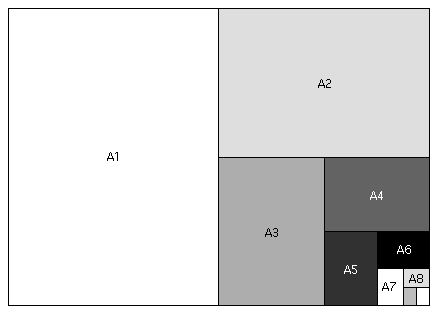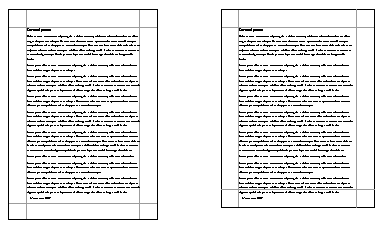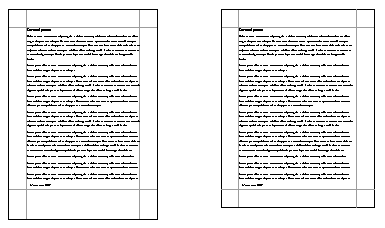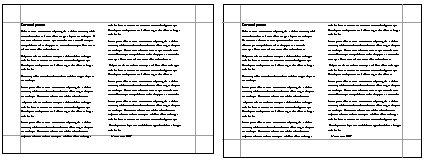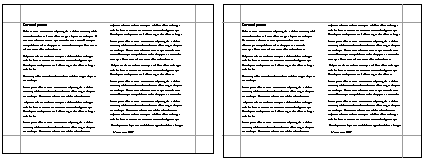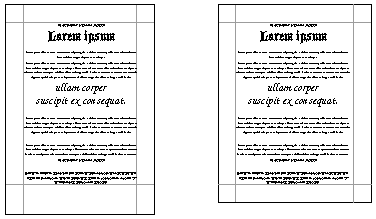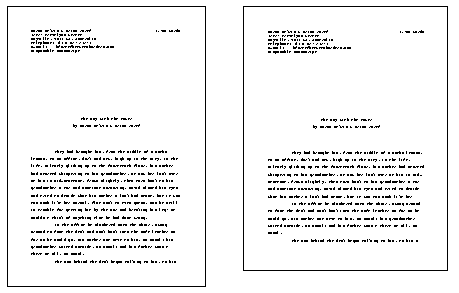Standard screenplay presentation format. Ask about it on most mailing lists or web-sites or at most screen-writing seminars and you'll get a variation on the following:
20 pound bond US Letter
Card stock covers
3-holes
Brads in top and bottom holes
Which is all well and good but overlooks two things.
These requirements don't apply outside the US film industry.
Even for those marketing their work into the US, this shorthand advice is of
no practical value.
These non-standard, non-metric, peculiar to the US (actually, peculiar to the US film industry in particular) requirements represent a real barrier to people outside the United States marketing their work into the US film industry.
Personally I'd love to say ‘stuff it, the rest of the world uses A4, and it's about bloody time you switched.'
That won't help sell screenplays, however. And, given how fetishistic the US film industry is about this stuff, such an attitude will actively harm a writer's chances.
I'd not have believed it myself but I had meetings -- both informal and formal -- with industry folk in LA in late-2001. Readers, agents and producers really do care about this stuff. Mostly because it serves as a shortcut method of reducing the size of their 'have to read this week' pile.
The 'a great story will win out' rule still applies but you make it a lot harder to have your great story read in the US if your material isn't presented as folk there expect.
So, ignoring all questions regarding the quality of your prose, and assuming you know enough to write a Master Scene script using standard margin and tab settings, you've still got work to do making sure what you send doesn't un-necessarily bias a US reader against your work.
Printing it on A4 paper and binding it using the Celco-brand flat-head steel binders common to Australian stationers is probably not a deal-breaker but it's not going to help.
Moreover, if you're entering one of the big three US-based screenwriting competitions -- Nicolls, Austin or Chesterfield -- it could well be a deal-breaker.
The Nicoll Fellowship, for example, officially allows A4 but puts your screenplay at the mercy of the photocopier should you make it to the quarterfinals, as per the following extract from their FAQ:
Q. Living in Europe, I only have access to paper that is longer than standard
American paper. Is it acceptable to submit a script on European (A4) paper?
A. Yes, it is. Try to leave a longer bottom margin (2 inches/5 centimeters
instead of 1 inch/2.5 centimeters) as scripts that advance to Nicholl
quarterfinals will be copied onto standard American paper (8.5 x 11 inches).
The Chesterfield doesn't mention anything about page size but it does require all screenplays entered into the annual competition be bound with 'plain white paper or cardstock and standard brads.'
And while it's past time for the US to switch to the metric system, sending your screenplay to a US screenwriting competition on 2-hole A4-paper with 'non-standard' binders isn't going to convince them of the merits of changing. Which is unfortunate because almost every difficulty presented by US screenplay presentation standards comes down to their dependence on Imperial measures.
The six things to be aware of before sending screenplays to a US reader are:
| 1. |
Paper Grade |
What is 'bond paper?' |
| 2. |
Paper weight |
And why does it weigh 20 pounds? |
| 3. |
Page size |
The US uses Letter (aka US Letter); the rest of the world uses A4. |
| 4. |
Cover |
Exactly what is 'Card Stock' anyway? |
| 5. |
Holes |
Three-holes vs two-holes vs four-holes. |
| 6. |
Brads |
And what are these 'Brads' they keep on about? |
Following is a detailed look at the specifics of US film industry habit with regards screenplay presentation and the ways to deal with them, given their non-standard nature. If you're only interested in the solutions and not how or why I arrived at them, skip straight down to the bottom where I've presented a short summary.
1. Paper Grade
Go into a stationer's here in Oz and ask for a ream of A4. One thing you won't be asked is 'what paper grade?' You might be asked what weight you want (see below) but, for everyday use, most of us consider paper generically.
Not so in the United States, where Paper Grade is not just of concern to publishers and printers. Everyday folk in the US need at least a passing familiarity with the differences between bond, book, bristol, bible, catalog (sic) and other grades of paper.
If you're interested in such minutae, Jacci Howard Baer has a useful article on Choosing Paper Grades for Desktop Publishing over in the About.com desktop publishing area.
For the rest of us, just note that bond paper -- also known as writing or xerographic paper -- is essentially equivalent to the paper we buy without thinking whenever we need to fill up a photocopier's or laser printer's paper tray.
Of more concern, is the paper's weight.
2. Paper Weight
Americans list paper weights using a complicated and non-intuitive system. So let's start with ours.
Paper weights in Australia (and Europe and England and Asia and pretty much everywhere A-series paper is also used) are listed in grams per square metre (g/m2). In speech, these weights are commonly referred to as 'gee ess emm' as in '80 gsm paper.' (Strictly speaking, the system is 'grams per A0 sheet' but A0 sheets are a square metre by design so the two terms are equivalent.)
Thanks to the simple relationship between each A-series size this system makes it easy to work out what an individual sheet of any sized paper weighs.
If you have 80 gsm A4 sheets, each sheet weighs 5 grams. A single A4-sheet is one-sixteenth the size of an A0-sheet and 80/16 = 5. 100 gsm sheets of A4 each weigh 6.25g. 120gsm A4 weighs 7.5g per sheet. And so on.
The same simple arithmetic applies to other sheets in the A-series. A3-sheets are one-eighth of an A0-sheet. So 80gsm A3 sheets weigh 10 grams each.
In the US things are nowhere near as simple. The so-called basic weight system used in the US works as follows: 500 sheets of Y-grade paper of dimensions A x B weighs Z pounds.
Put another way, a sheet's basic weight is the number of pounds a ream of a specific grade of paper cut to a standard size will weigh. Paper grades used in the US (eg bond, cover, bible and bristol) have no direct analogues outside the US. And each of these grades has a different standard size. Book paper, for example, has a standard size of 635mm by 889mm (25˝ by 38˝). Bond paper, however, has a standard size of 431.8mm by 558.8mm (17˝ by 22˝).
Remember, the actual size of the sheets of paper in front of you aren't important. If you have a ream of US Letter (8.5˝ by 11˝ or 215.9mm by 279.4mm) and it's described as '20 pound bond' the 20 pounds refers to how much the ream would weigh if the sheets were 17˝ by 22˝.
So, how do we relate this to our g/m2 system?
Let's start with the only part of this the two systems have in common: the word 'ream.' 500 sheets is a ream of paper both within and without the US.
The paper grade is a bit of publishing and printing arcana leaking into the everyday realm. The very basics are noted above but, for our purposes, we're only concerned with one grade: bond.
The dimensions used (the so-called ‘standard size' from which the basic weight is derived) are further arcana, since they are trade sizes which have little to do with the sizes used in offices and homes.
As noted above, for bond paper the dimensions used are 17˝ by 22˝ (431.8mm by 558.8mm). That's twice the dimensions of a single sheet of US Letter, which is the actual paper size we are interested in.
And the only weight we care about is 20 pounds, the weight specified as 'standard' by every US-based screenwriting book, site and guru I've come across.
So, 500 sheets of 17˝ by 22˝ bond paper weighing 20 pounds is where we start. 20 pounds is 9.07 kilograms (9070 grams). Divide by 500 and we get the weight of each sheet: about 18 grams.
These standard sheets are 431.8mm by 558.8mm, giving each an area of 241,290mm2 or about 0.2413m2. US Letter sheets are 215.9mm by 279.4mm, giving an area of 60,322.5mm2 or about 0.06032m2.
These aren't particularly friendly numbers but 241,290/60,322.5 is. It's a nice round 4. A 17˝ by 22˝ sheet is four times the area of a sheet of US Letter. So a sheet of 20 pound US Letter should weigh a quarter of a 17˝ by 22˝ standard sheet. And 18/4 gives us a weight per sheet of 4.5 grams.
With a little further arithmetic (4.5/0.06032) we find 4.5 grams per US Letter sheet is pretty close to 75g/m2.
(For those that didn't follow the arithmetic: it's the weight of a single US Letter sheet divided by the area of said sheet. Since the area is expressed as a fraction of a square metre, the answer -- 74.6 to three significant figures -- turns out to be how much a square metre of paper would weigh if a Letter-sized sheet of the same paper weighs 4.5g.)
All of which is the tedious process needed to discover '20 pound bond' is somewhere close to what we'd call '75 gsm' paper.
Don't celebrate just yet. You aren't going to find 75 gsm paper at your local stationers. Standard office-paper is 80 gsm. Depending on how extensive a range your stationer carries you might also find 100 gsm paper and even 70 gsm paper. This latter is considered a 'draft' weight: too light for anything other than testing or checking before the finished document is printed on 80 gsm sheets.
No-one, however, carries pre-packaged 75 gsm sheets. Of course, you can pay a lot extra and get 75 gsm paper made up, but don't bother.
Standard 80 gsm paper cut to US Letter size weighs about 4.8 grams per sheet. 120 sheets of such paper weighs a touch under 580g. (Remembering 120 pages represents a 2-hour screenplay, about as long as you want a spec screenplay to run.) 120 sheets of '20 pound bond' cut to US Letter size weighs 540g.
40g difference in a 600g range (ie a difference of about 7%) is on the threshold of what people can detect by plain heft. I've not checked with anyone but I strongly suspect the difference is too small to care about.
Which brings us to paper size.
3. Page size
80 gsm A4 office paper is easy to find. US Letter, however, is not.
You won't find US Letter at OfficeWorks or Office National or your local stationer or newsagency. This non-standard size must be cut from a standard mill size (probably C3 or A3).
Not every stationer will do this for you. OfficeWorks, for example, doesn't do this sort of special order. An Office National store may -- Office National is a franchise rather than a chain, and services such as custom-paper ordering are in the hands of individual franchisees.
Your best bet is to find a Manufacturing Stationer. Wigg & Sons is a good example of such a stationer and they have offices in Adelaide, Brisbane, Melbourne, Sydney and Perth. According to the Wiggs' retail outlet in Adelaide, 80gsm US Letter costs around A$18.00 a ream, special ordered.
In late-October 2002, an Office National retail outlet in Sydney quoted me A$14.00 a ream for 80gsm US Letter. They also noted the turnaround time on such an order would be 'four to five days minimum.' This because the stationer has 'minimum order sizes with the mill and it takes a while to build-up special orders to the required value.'
The minimum order size concerns the amount of non-standard paper ordered and cut, not the amount of one non-standard size ordered. An informal survey of stationers in several states made it clear US Letter is a vanishingly rare special order size.
So don't depend on even a manufacturing stationer knowing what 'US Letter' is. Some stationers remember it as 'US Quarto,' an old British term, but others have no idea of the paper size, nor its dimensions (215.9mm by 279.4mm). Have these figures to hand before placing your order.
Whether its A$14.00 or A$18.00 a ream, or something inbetween, this is expensive compared to the A$5.00/ream standard A4 sheets cost. On the other hand, it's likely the only option currently available. As of January 2003, ordering US Letter from the United States appears impossible, all questions of cost aside.
Of the major US stationery supply stores only Amazon.com offers any sort of shipping outside the United States. Office Max 'only ships to the 50 US states, Puerto Rico and the US Virgin Islands.' Office Depot does not 'currently accept orders outside the United States.'
And so it is with Staples, which 'can offer delivery only to addresses within the United States.' Staples does have physical stores in the UK and Germany but these stores don't carry US Letter or any other US-specific stationery. Other US-based on-line office supply stores that don't ship outside the US include Quill and Reliable.
Finally, of the two specialist screenwriter's supply stores I'm aware of -- The Writers' Store and Script Supplies -- the former does ship outside the United States but doesn't carry paper and the latter does carry paper but doesn't ship outside the United States.
Which brings us back to Amazon.com. Unfortunately, it turns out their stationery store is simply an Amazon.com-branded front for Office Depot, which I've already noted doesn't ship outside the US.
So, special ordering is the way to go. Only question now: should you also special order the holes?
4. Holes
The three-hole system used in the US was once common in Australia and elsewhere. As metrication has rolled across the globe, however, it has fallen out of use, leaving only vestigal signs of its existence.
Outside the US, the standard for filing loose-leaf paper in folders is a two-hole system described by ISO 838. The fully-documented specifications for this standard are available for sale as either PDF or paper files from the ISO's on-line catalogue.
Put briefly, ISO 838 specifies two holes about 6mm in diameter, 80mm apart, 12mm in from the left-edge of the sheet and set symmetrically around the central axis of the sheet. A very common, albeit unofficial, extension of this standard adds two holes 80 mm above and below the central two.
The two-hole system works for sheets as small as A7 (74mm by 105mm) and is widely used in offices, perhaps most commonly in conjunction with those ubiquitous two-hole lever-arch folders.
The upwards-compatible 4-hole system, which isn't useful on anything smaller than A4, is used mostly in education, thanks to the ubiquitous 4-ring folders dispensed by school stationery suppliers.
By comparison, the 3-hole system appears to be designed around US Letter alone. The middle hole is just that: drilled 140mm down the page, half-way down the 279.4mm length of a US Letter sheet. The top and bottom holes are then placed 108mm above and below the middle hole.
The diagram below shows a scaled down sheet of A4 with black circles representing where the ISO 838-standard holes go. The grey circles above and below are where the extra two holes are punched for four-hole paper. For comparison, I've placed a 3-hole US Letter sheet reduced to the same scale on the right.

All this said, pre-drilled paper isn't particularly common at your local stationer. Student A4 pads, pre-lined with 7 pre-drilled holes and a red gum binding down the left-hand edge are common enough but hardly suitable for printing screenplays.
Morover, almost all pre-drilled paper available in Australia follows the student pad pattern of having 7 holes. This makes it possible to slip the paper into 2-ring, 4-ring and even old 3-ring folders but, again, doesn't make the paper useful for our purposes.
Which leads us back to the question above: when special-ordering a ream of US Letter, should you also get it pre-drilled?
Every OfficeWorks store I'm aware of has a copy centre in-house which offers a range of binding services including hole-drilling. As of January 2003 they charge A$1.10 per hole per half-ream. And they don't charge extra for odd-paper sizes. Getting three holes drilled in a ream of US Letter will, therefore, set you back A$6.60.
By contrast, Wigg & Sons Adelaide quoted A$10.00 extra for pre-drilling special ordered US Letter.
Finally, if you'll be needing a lot of drilled paper, I can recommend the Open D-4 Adjustable Drill Hole Punches. At A$150.00 they aren't cheap (although I've seen them for less and picked up mine for less than A$100.00) but they have pre-sets for the US 3-hole system and can take over 100 sheets of 80 gsm paper in one go.
A$150.00 will get nearly 23 reams of US Letter pre-drilled at an OfficeWorks copy centre, enough for nearly 100 screenplays. Against that, OfficeWorks Copy Centres aren't open late at night and, with two high-school students plus an academic in my household, the Hole Punches get used for a lot more than preparing screenplays.
5. Covers
Standard advice for US screenplay covers -- front and back -- is that they be left completely blank and be made of 'card stock.'
Card stock, which is also known as index paper, turns out to be another of those paper grades everyday people have to keep track of in the US. It's a stiff paper often used for index card catalogues (hence the alternative name). It's basic weight is derived from a standard size of 647.7mm by 774.7mm (25.5˝ by 30.5˝) and the most common basic weight appears to be 110 pounds (almost 50kg).
Running through the arithmetic very quickly: a basis weight of 50kg means a single sheet of 647.7mm by 774.7mm card stock weighs 100g. Which means a single US Letter-sized sheet of card stock weighs 12g.
Without torturing you with further arithmetic, this equates to 200 gsm paper.
200 and 250 gsm paper isn't that hard to find, but it's mostly sold as A2 sheets called Colourboards. Despite this name, they can be had in white (the recommended colour for screenplay covers).
A single A2 250 gsm White Colourboard costs around A$1.00. Copy centres which offer custom trimming will turn five such sheets into ten US Letter-sized covers for between A$0.40 and A$0.60, although you'll likely have to measure up the outlines yourself. Every copy centre I called offered rulers and scoring knives in-house.
Custom trimming is commonly charged per trimmed edge per five sheets. It takes four trims to cut two US Letter sheets out of an A2 sheet. For example, if a copy centre charges A$0.10 per trim per five sheets, we get the A$0.40 noted above.
Getting three holes drilled is charged at the same rate noted above: A$1.10 per hole per half-ream. Given this, I'd recommend getting cover-holes drilled at the same time as you get your reams of US Letter drilled. At least one person I spoke to at an OfficeWorks Copy Centre suggested they could ‘slip the trimmed Colourboards in as part of the 80 gsm drilling.' Not a huge saving (and not even a guarantee of one) but better than nothing.
Which leaves us, finally, with those strange objects the US film industry demands slide into these holes.
6. Brads
Let's get the word out of the way first. In most of the English-speaking world, dual-pronged widgets for holding piles of paper together are called paper fasteners or paper binders. In the US film industry, however, these same widgets are called brads.
Brad comes, via Middle English, from the Old Norse 'broddr' meaning spike.
The word has a long history in British and American English but has fallen out of regular use outside the US film industry. Even here it's use appears to be a relatively recent extension of an older meaning.
According to the American Heritage Dictionary, brads are 'thin wire nails with a small head or a slight side projection instead of a head.'
One of several secondary meanings, however, is 'a small wire nail, with a flat circular head.' It's not much of a stretch from this to the US film-industry use: a brass or brass-coloured, round-head, dual-pronged paper fastener; more specifically an Acco-brand #5 Solid Brass Fastener. The Acco-brand widgets are the particular 31mm-long fasteners US film-folk mean when they say 'brads.'
Unfortunately, knowing what brads are won't help you find them at a stationers. Acco Australia does not distribute #5 Solid Brass Fasteners locally. According to Acco Australia's Marketing Manager, John Verdigan, 'it's only a A$50,000.00-a-year market. It doesn't really get onto our radar.' Those dollars aren't all spent by screenwriters entering US competitions and marketing to US prodcos, BTW. According to Verdigan these style fasteners are also used in legal circles.
Both Celco and Premier-Grip (the latter distributed in Australia by Esselte) produce similar fasteners to the Acco #5s but neither is an adequate substitute, at least for screenwriters. They are apparently fine for binding lawyer's briefs.
Celco produces a 31mm Paper Fastener which is gold-coloured and has a rounded head. Acco #5s have a 12mm head, however, where the head on the Celco fastener is only 8mm in diameter. The extra 4mm ensure the Acco-brand fasteners don't slide throught the holes. As well, the Celco fasteners are tin, with narrower prongs and a gold flake coating. They are fine for holding a few pages together but aren't up to the task of keeping 120 pages from falling apart.
Premier-Grip also offer a gold, round-headed 31mm paper fastener. It has almost identical construction as the Celco fastener except for the head, which is only 6mm in diameter.
Which leaves two choices: import them or buy them in the US.
On this latter front I'll note three things. When I was in the US for several months in late 2001, they weren't as easy to find as you might think. I wandered into half-a-dozen Office Depot, Office Max and Staples stores in Austin, San Francisco and even Los Angeles looking for brads without luck. That's not to say they weren't there, just that I couldn't find them. That said, my LA-native host couldn't find them in the Office Depot and Staples stores we tried in Los Angeles either. (For accuracy's sake I'll also note there aren't any Staples stores in Austin, Texas or there weren't any as of November 2001).
I ended up buying my supply of brads from The Writers' Store walk-in shopfront on Westwood Boulevard in Los Angeles.
The second thing to note. While I was in the Writers' Store I made sure to pick up a collection of Acco Round-Head Solid Brass Washers. It turns out the washers don't come in the box. A little nugget worth remembering if, like me, you are used to buying Celco-brand steel binders which include steel washers in the box.
Finally, when buying brads in the US to bring back to Australia, don't put them in your hand luggage. I didn't do this but I did have to explain what 'all that metal' was every time my stored luggage was x-rayed (which was at every airport: given the number of EU, Chinese, British, New Zealand and Australian passports I saw each time my luggage and I were searched I'm inclined to believe non-US folk get the bulk of US airport security staff attention).
I'm confident anyone putting packs of 31mm, sharp, pointed metal into their hand luggage will lose said packs and spend more time than they'd like getting through security.
Finally, you can buy Acco-brand fasteners and washers on-line. Be prepared for some serious sticker shock, however.
The Writers' Store offers Acco-brand #5 brads at US$8.00 for a box of 100 and Acco-brand #2 Round-Head Solid Brass Washers at US$2.50 for a box of 100.
Converted to Australian dollars at US$0.70 per Australian dollar (a conservative rate as of April 2004, albeit astonishingly high to those of us who remember the late-1990s and rates of US$0.49 to the A$1.00) this is around A$15.00 for 100 brads and 100 washers.
This isn't the worst of it. Next are the shipping charges.
The Writers' Store web-site appears to offer only one international shipping method: Federal Express (FedEx) International Priority. Said method adds US$43.00 to the cost.
Which makes a box of Acco brads and an accompanying box of Acco washers cost A$76.50!
On the up-side, the FedEx cost doesn't change much as you increase the number of boxes ordered. If you order 20 boxes of brads and 20 boxes of washers, the FedEx bill only goes up to US$53.00. A$15.00 for 100 paper fasteners and 100 washers is exhorbitant but getting a mob of fellow screenwriters together to order the widgets en masse will make the freight easier to bear.
If you don't have extra screenwriters handy, there is an unpublicised alternative. Vince Afner, Product Fulfillment Manager at The Writers Store, let me know by e-mail that people can 'state in the comment field they would like their order shipped by post [ie standard mail --BF] and The Writers' Store will not charge their card for the FedEx rate even though the order lists the FedEx rate.'
Afner further noted the cost of shipping a package via US mail is 'around US$10.00' (about A$14.00).
Finally he wrote the Store is 'working on cheaper rates for our international customers.' [April 2004 addendum: they appear to still be 'working' on this --BF]
I didn't test this procedure out and A$29.00 (A$15.00 for brads and washers plus A$14.00 postage) is still very expensive but it's a lot less than A$76.50.
Folk in Britain used to have a local source of Acco #6 brads (6mm longer than #5 brads): the London-based Screenwriters' Store. As of April 2004 at least they no longer carry these items.
Conclusion
A$14.00 for a ream of 80 gsm US Letter.
A$16.60 to drill 3 holes.
A$10.00 for ten sheets of 250 gsm Colourboard.
A$10.40 to trim into 10 covers.
A$29.00 to ship 100 Acco #5 brads & #2 washers from LA.
A$50.00 Total.
And I've quoted in the low range and I haven't factored in labour costs, time and petrol spent running around, the postage or the cost of entering any of the competitions.
If you're entering one of these competitions, make your screenplay as good as you possibly can, and then make it a little better.
And start hassling any American you know about going Metric.
Summary
| 1. |
Bond Paper |
Bond is the term used in the US to describe everyday writing and printing paper. If your sheets can be safely run through a photocopier or laser printer they are close enough to bond for our purposes. |
| 2. |
20 pounds |
20 pound bond is equivalent to 75gsm. Don't bother hunting for this weight. 80 gsm, which is the standard paper weight used for photocopy and laser printer paper, will be fine.A 120-page screenplay printed on 80 gsm US Letter paper will be about 40g heavier than 120-pages of 75 gsm. Too small a difference to worry about. |
| 3. |
US Letter |
You can't get it off the shelf in Australia. You can special order it from some stationers. Using 80 gsm paper as the base, it will cost anywhere from A$14.00 to A$18.00 a ream.
Don't assume the stationer knows the page's dimensions, which are 215.9mm by 279.4mm. It can take up to five days for the order to arrive. |
| 4. |
Holes |
Pre-drilled paper is rare and pre-drilled 3-hole paper is (for practical purposes) non-existent. Getting special-ordered US Letter pre-drilled will add around A$10.00 to the price.
Alternatively, take your special ordered ream to an OfficeWorks Copy Centre and get it 3-hole drilled for A$6.60. OfficeWorks drilling machines should have pre-sets for the 'US 3-hole system' so ask for that by name.
Heavy paper users can bring one step of the process in-house with an Open D-4 Adjustable Drill Hole Punch. They cost A$150.00. |
| 5. |
Cover |
Card Stock is a heavy grade of stiff paper which equates to 200 gsm. 200 or 250 gsm paper is easiest to get locally as A2 Colourboards, running about A$1.00 per sheet. Buy them in lots of five.
Do this because custom trimming tends to be charged per five sheets and per trimmed edge. A copy centre that offers custom trimming will charge from A$0.40 to $A0.60 per five sheets to make four cuts into five A2 sheets to produce ten US letter-sized covers. You'll likely have to rule up where to make the trims yourself, however. |
| 6. |
Brads |
Acco #5 Solid Brass Paper Fasteners (aka Brads) and their accompanying Acco #2 Solid Brass Washers are not available locally. No equivalent substitute is available either.
A box of 100 brads and a box of 100 washers will set you back at least A$29.00 if ordered from The Writers' Store. You'll get this price only if you ask for standard mail in the Comments field of the order page. Without this request the brads will be shipped International FedEx, upping the price to more than A$75.00. This latter extravagance can be ameliorated by ordering brads in bulk (eg by a group) since the FedEx shipping only increases marginally when you bulk up the order. |



